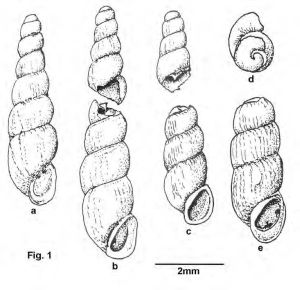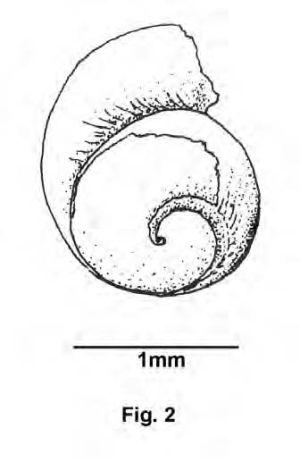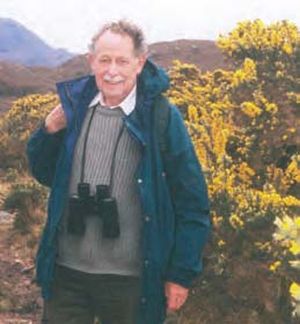|
Ted Phorson died peacefully in April this year, at the age of 81. Ted had become a good friend in conchology and over the years we had corresponded and sent shells shuttling back and forth courtesy of Royal Mail in an attempt to seek each other’s opinion over problematic specimens. We had several things in common, both coming to conchology by a circuitous route having started out as linguists specialising in French. Ted read French at Durham University but his studies were interrupted for some years owing to wartime service as an Artillery Officer and it was not until 1947 that he was able to return to Durham to complete what he had started in 1942. He met his wife Joyce at University and after their marriage they settled on the outskirts of that city. Ted’s professional life was spent initially as a school-teacher and subsequently as a lecturer at Durham University for twenty years. In Ted’s words, “It was the exploration of rock pools with my young daughter which aroused my interest in shells and the desire to know more about them.” Ted acquired some of the standard texts to help identify his finds and Shelagh Smith offered encouragement in those early days. Ted Phorson joined the Society in 1981, coincidentally the same year that I was elected to membership. (It would be 8 years before our paths crossed). In his first year as a member he published an article in which he recounted the excitement of experiencing a beaching of Janthina and Velella on the Quiberon Peninsula (Phorson, 1981), the first of a series of contributions to the Society’s publications. In the following year he wrote an informative article on his observations of shell repair, but it was in 1984 that his article, The Trouble with those Juvenile Delinquents, appeared in the Newsletter and was to foreshadow the strand of conchology that would absorb Ted for the succeeding 22 years. The acquisition of a good binocular microscope triggered the new area of interest, and he entered a world of uncertainty when sorting a sample of shellsand with its resultant residue of unidentified specimens: a mélange of microspecies and juveniles and problems in distinguishing the two categories. Ted’s approach was to sort a small sample of shellsand, perhaps a teaspoonful, grain by grain! Based on the molluscan composition Ted would often find that he could assemble a sufficiently large number of specimens of a particular species, to build up a continuous series of shells that would ultimately bridge the gap between the puzzling juveniles (Ted’s delinquents) and the more familiar adult form. In that first article Ted shared some of his discoveries with the reader, drawing many with a camera lucida, and he published further articles over the years thus expanding the range of species figured as his collection grew. An example of Ted’s drawings accompanies this article: by sorting through shells and fragments gleaned from an interstitial sediment sample taken from a shingle beach at high water mark, he retrieved enough examples to trace the process of decollation that occurs during maturation of Truncatella subcylindrica. Ted was very willing to re-evaluate his own identifications. He was also prepared to challenge more authoritative determinations and could sometimes be quite stubborn! Others chimed in with their Newsletter contributions to this line of enquiry, notably Phil’ Palmer who observed that “we should stop calling the puzzles ‘juvenile delinquents’ for they are just juveniles while we are the delinquents for remaining in ignorance about an important part of molluscan studies!” Ted seldom travelled to meetings but he did attend a Molluscan Workshop in 1989 and brought examples of his growth series which impressed us all very much. Fortunately, this meeting was a foundation for conchological friendships that Ted maintained from his Durham outpost. Also at this meeting he met John Whittaker of the BM(NH) who helped him with some unidentified ostracods and forams, two additional groups that Ted was beginning to working with. In succeeding years he widened his circle of correspondents in molluscan studies and published in a number of periodicals. Ted suffered a stroke in September 2000. In many respects he recovered well from this setback but it left his speech impaired. We continued to correspond and happily for Ted, Joyce was a willing participant in the 3-way conversations we had over the phone. His interest in his shells remained undiminished and he continued working on his growth series. When Harriet Wood and I visited Ted in 2004 to discuss his wish that the National Museum of Wales should be the beneficiary of his collection he produced a copy of his catalogue. He had a good working collection of northeast Atlantic marine molluscs but the highlight for me was the collection of growth series for 160 marine mollusc species. I had seen certain species over the years when Ted loaned them to me to help with identification problems, but I had not seen the collection as a whole. It is beautifully curated and is testament to the hours of patient dedication Ted applied to his quest for greater understanding of microscopic shells. The staff of the Mollusca Section at the National Museum of Wales in Cardiff where the Phorson collection will be housed are keen to ensure that this exciting new bequest will be available to visitors. The collection is unusual in that the principal component consists of shells mounted on microscope slides, and hence will be kept separately in slide cabinets rather than integrated into the systematic collections as most new acquisitions are. There is a new project starting at NMW in September, that will be able to make use of the Phorson collection. Graham Oliver and Anna Holmes will be working on a new guide to British Marine Bivalves for the next three years. This guide will provide illustrations of bivalves at different stages from juvenile to adult, and hence the Phorson collection will be invaluable as a source for this project providing material of many of the smaller British species. This will be a fitting tribute to Ted and the innumerable hours that he invested in his juvenile delinquents. Contributions to Conchologists’ Newsletter.1981 Janthina on the Quiberon Peninsula. No. 78. p.323 1982 House repairs and alterations. No. 82 p.19 1984 The Trouble with those Juvenile Delinquents. No. 89 p.161 1988 Caecidae in France and Guernsey. No. 104 p.72 1988 Neolepton sykesi and Neolepton sulcatulum in Guernsey. No. 106 p.117 1989 Observations on juvenile shells of Retusa truncatula, Philine catena and Philine punctata. Conchologists’ Newsletter. No. 111 p.223 1990 Philine angulata in NW Scotland Conchologists’ Newsletter. No. 112 p.257 1990 Some observations on the development of juvenile shells of Trivia. Conchologists’ Newsletter. No. 113 p.279 1990 Some observations on juvenile shells: Chauvetia brunnea and Epitonium clathratulum. Conchologists’ Newsletter. No.114 p.312 1991 Some observations on juveniles and growth series of Leucophytia bidentata and Ovatella myosotis. Conchologists’ Newsletter. No. 117 p.367 1996 Observations on the development of dentition in small juveniles of certain species of Mytilidae. Conchologists Newsletter. No. 136. p. 603
|
Figure 1 a. Whole shell of Truncatella subcylindrica just before decollation b and c: After abscission: in each case, the two parts are not the same shell, but matched for whorl size. d. End view of the decollated shell showing sealed septum and geometry of the break. e. Decollated specimen in which the growth lines are exaggerated to become costae.
Figure 2 Enlarged view of Figure 1d. Note: Phorson noted that the geometry of the manner in which the septum seals the hole is complicated, as is the line of abscission. Specimens he examined showed that the greater part of the line of abscission is a neat cut (or break) immediately above the suture but this leads round to a more ragged break at the highest point of the cut. The septum is not a regular dome but conforms to the geometry of the cut spiral but what he found intriguing is that the animal forms not just a plain protective area of shell over the hole, but moulds it into a well-formed pseudo-protoconch.
|
Ted Phorson: A personal recollection
Issue
12
Page
8



 Figure 3 Colour photo of Ted Phorson
Figure 3 Colour photo of Ted Phorson